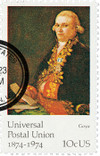
# 1537 - 1974 10c Famous Works of Art: Goya
1974 10¢ F. J. de Goya
Famous Works of Art
Quantity: 26,769,600
Opening Of The Armory Art Show
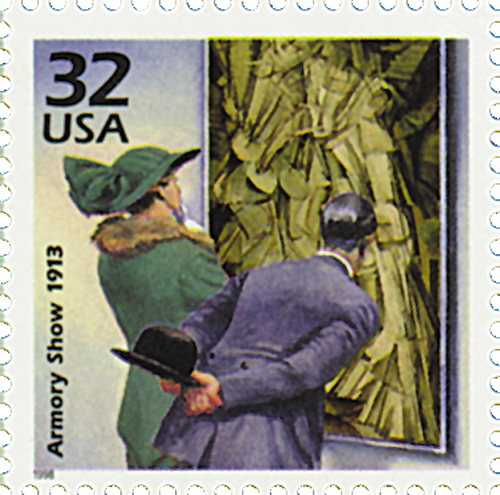
On February 17, 1913, the Armory Show opened at the 69th Regimental Armory in New York City, giving many in the public their first exposure to Modern Art.
In December 1911, a group that eventually became known as the Association of American Painters and Sculptors (AAPS) met to talk about the nation’s art scene. Among the topics, they discussed the possibility of exhibiting American and foreign art that was often ignored or rejected by mainstream exhibitions.
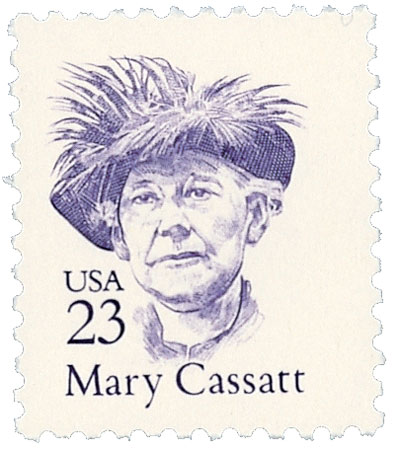
The following year, they established the AAPS with the goal to “lead the public taste in art, rather than follow it.” In addition to creating new exhibition opportunities for young artists, they also sought to educate the American public on modern art. Their first major undertaking was the International Exhibition of Modern Art to be held at the 69th Regiment Armory in New York City.
With the site selected and paid for, the organizers then had the arduous task of selecting artwork. The organizers wanted to include a large number of European artists, so they traveled to England, Germany, the Netherlands, and France. Among the most famous works they secured on this trip were Matisse’s Blue Nude (Souvenir de Biskra) and Madras Rouge (Red Madras Headdress), and Duchamp’s Nude Descending a Staircase, No. 2. Once they returned to America, the organizers officially invited American artists to participate.
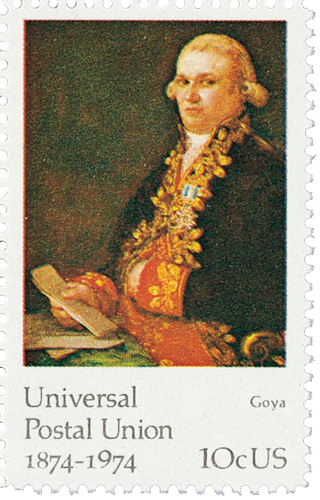
The Armory Show, as it came to be known, officially opened on February 17, 1913. It included about 1,300 paintings, sculptures, and decorative works by more than 300 artists. Their works represented the Impressionist, Fauvist, and Cubist movements.
The show marked the first time most Americans saw modern abstract art (though Arthur Dove had displayed his abstract works the year before, which is considered the first public exhibition of abstract art in America). Among the artists who participated were Stuart Davis, John Marin, Marsden Hartley, Charles Sheeler, Joseph Stella, and Marcel Duchamp. Many viewers were outraged, including former President Theodore Roosevelt, who proclaimed, “That’s not art!”
In spite of the public reaction, many artists in attendance were inspired and joined the modern art movement. These included Man Ray and Aaron Douglas. The work of all these artists paved the way for more abstract art in America by such artists as Charles DeMuth, Georgia O’Keeffe, and Gerald Murphy.
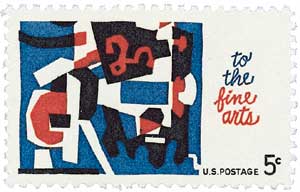
After the show closed in New York on March 15, it traveled to Boston and Chicago. Altogether some 300,000 people attended it. Overall, Americans were shocked by their first look at modern art, and the Armory Show was received with widespread debate. Marcel Duchamp’s cubist painting, Nude Descending a Staircase, No. 2, which suggests motion by blending a series of images, probably caused the greatest sensation and controversy of the exhibit.

The Armory Show introduced the U.S. to modernism. In the decades to follow, its impact on American art would come to be accepted, understood, and greatly valued.
Click here for a virtual gallery of the Armory Show.
1974 10¢ F. J. de Goya
Famous Works of Art
Quantity: 26,769,600
Opening Of The Armory Art Show

On February 17, 1913, the Armory Show opened at the 69th Regimental Armory in New York City, giving many in the public their first exposure to Modern Art.
In December 1911, a group that eventually became known as the Association of American Painters and Sculptors (AAPS) met to talk about the nation’s art scene. Among the topics, they discussed the possibility of exhibiting American and foreign art that was often ignored or rejected by mainstream exhibitions.

The following year, they established the AAPS with the goal to “lead the public taste in art, rather than follow it.” In addition to creating new exhibition opportunities for young artists, they also sought to educate the American public on modern art. Their first major undertaking was the International Exhibition of Modern Art to be held at the 69th Regiment Armory in New York City.
With the site selected and paid for, the organizers then had the arduous task of selecting artwork. The organizers wanted to include a large number of European artists, so they traveled to England, Germany, the Netherlands, and France. Among the most famous works they secured on this trip were Matisse’s Blue Nude (Souvenir de Biskra) and Madras Rouge (Red Madras Headdress), and Duchamp’s Nude Descending a Staircase, No. 2. Once they returned to America, the organizers officially invited American artists to participate.

The Armory Show, as it came to be known, officially opened on February 17, 1913. It included about 1,300 paintings, sculptures, and decorative works by more than 300 artists. Their works represented the Impressionist, Fauvist, and Cubist movements.
The show marked the first time most Americans saw modern abstract art (though Arthur Dove had displayed his abstract works the year before, which is considered the first public exhibition of abstract art in America). Among the artists who participated were Stuart Davis, John Marin, Marsden Hartley, Charles Sheeler, Joseph Stella, and Marcel Duchamp. Many viewers were outraged, including former President Theodore Roosevelt, who proclaimed, “That’s not art!”
In spite of the public reaction, many artists in attendance were inspired and joined the modern art movement. These included Man Ray and Aaron Douglas. The work of all these artists paved the way for more abstract art in America by such artists as Charles DeMuth, Georgia O’Keeffe, and Gerald Murphy.

After the show closed in New York on March 15, it traveled to Boston and Chicago. Altogether some 300,000 people attended it. Overall, Americans were shocked by their first look at modern art, and the Armory Show was received with widespread debate. Marcel Duchamp’s cubist painting, Nude Descending a Staircase, No. 2, which suggests motion by blending a series of images, probably caused the greatest sensation and controversy of the exhibit.

The Armory Show introduced the U.S. to modernism. In the decades to follow, its impact on American art would come to be accepted, understood, and greatly valued.
Click here for a virtual gallery of the Armory Show.







